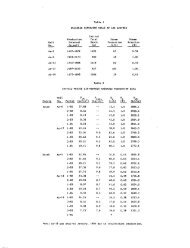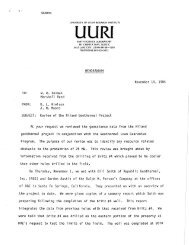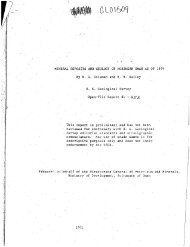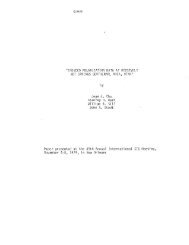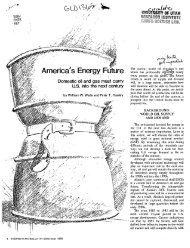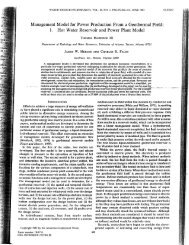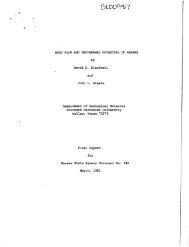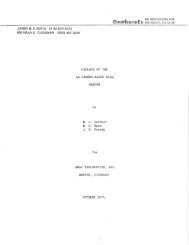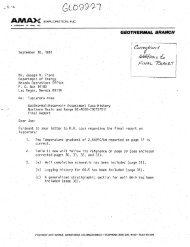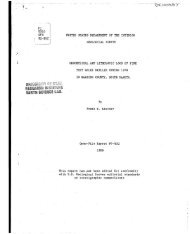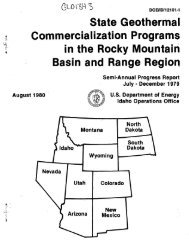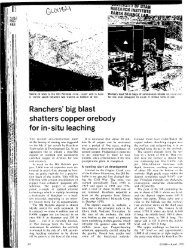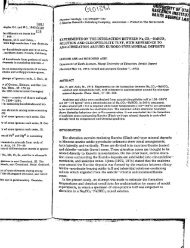Figure I Generalized map of the Wilbur Mining ... - University of Utah
Figure I Generalized map of the Wilbur Mining ... - University of Utah
Figure I Generalized map of the Wilbur Mining ... - University of Utah
You also want an ePaper? Increase the reach of your titles
YUMPU automatically turns print PDFs into web optimized ePapers that Google loves.
PART II<br />
HEAT LOADS, WELLS. HEAT EXCHANGERS,<br />
AND PUMPS<br />
Heat Load Detennination<br />
Commercial District Heat Load. Since it is impractical<br />
to do detailed heat loss calculations on<br />
each <strong>of</strong> <strong>the</strong> downtown buildings, a typical block was<br />
chosen and <strong>the</strong> total downtown area heat loss projected<br />
from <strong>the</strong> values obtained.<br />
The typical block was selected to contain a<br />
mix <strong>of</strong> building construction with particular attention<br />
to materials, number <strong>of</strong> floors in <strong>the</strong> buildings,<br />
display windows, and type <strong>of</strong> business. The<br />
block chosen is bounded by North 7th, North 8th.<br />
Main, and Pine Streets. Building construction is<br />
primarily masonry (brick) with built up ro<strong>of</strong>s and a<br />
good mix <strong>of</strong> ceiling heights, some <strong>of</strong> <strong>the</strong> establishments<br />
having been remodeled with lowered ceilings.<br />
Businesses include an insurance <strong>of</strong>fice, two jewelry<br />
stores, two clothing stores (1 men's, 1 women's),<br />
an <strong>of</strong>fice supply store, two home furnishing stores,<br />
a photographer's studio, a restaurant, and an outdoor<br />
sporting goods store with <strong>of</strong>fice space on <strong>the</strong><br />
second floor.<br />
The heat loss <strong>of</strong> each establishment was calculated<br />
using ASHRAE recommended procedures and design<br />
temperature for <strong>the</strong> Klamath Falls area. Actual<br />
values used were: inside temperature <strong>of</strong> 60°F<br />
(with 10°F night setback during <strong>the</strong> coldest nighttime<br />
periods); and design temperature <strong>of</strong> 0°F,<br />
which will include 99% <strong>of</strong> <strong>the</strong> time. Each establishment<br />
was inspected, measured, and construction<br />
estimated and/or obtained from <strong>the</strong> building occupants.<br />
Heat losses were estimated based on ASHRAE<br />
values for <strong>the</strong> materials and construction involved,<br />
with wind speed <strong>of</strong> less that 7 raph.<br />
Meteorological data was obtained from <strong>the</strong> U.S.<br />
Wea<strong>the</strong>r Bureau downtown station for January, 1978,<br />
and <strong>the</strong> degree days for <strong>the</strong> month calculated. Heat<br />
losses for <strong>the</strong> buildings were again calculated<br />
using <strong>the</strong> January wea<strong>the</strong>r data and estimated fuel<br />
consumption was compared with actual fuel consumption<br />
obtained from building occupants' January<br />
fuel bills. Calculated values were H.9% higher<br />
than actual fuel consumption.<br />
From <strong>the</strong> information thus obtained, a heat<br />
load constant <strong>of</strong> 4.34 BTU/H/ft^ based on building<br />
volume was estimated and applied to building volumes<br />
obtained from <strong>the</strong> City Planning Department.<br />
Fuel consumption and process heat loads were<br />
obtained from special case establishments in <strong>the</strong><br />
proposed district. Domestic hot water was estimated<br />
at ^0% <strong>of</strong> <strong>the</strong> district heat requirements.<br />
These loads were added to <strong>the</strong> loads calculated on<br />
<strong>the</strong> basis <strong>of</strong> building volume to obtain <strong>the</strong> total<br />
heat load.<br />
Future expansion was provided for by adding<br />
approximately 12% to <strong>the</strong> building volume heat load<br />
estimates but no additional high process loads<br />
were estimated since zoning restrictions prohibit<br />
385<br />
Lund, et. al.<br />
such future expansion in <strong>the</strong> area covered by this<br />
district.<br />
Total estimated heat load for <strong>the</strong> downtown<br />
district is 135 x 10^ BTU/hr and will require<br />
6,750 gpm <strong>of</strong> 200°F water with a 40°F temperature<br />
drop.<br />
The heat loads for 10 <strong>of</strong> <strong>the</strong> 14 buildings included<br />
in <strong>the</strong> initial district had been estimated<br />
using ASHRAE methods for <strong>the</strong> 1977 county feasibility<br />
study. Actual consumption <strong>of</strong> fuel was compared<br />
against estimated consumption for a period <strong>of</strong><br />
5 years for that study. Estimated consumption was<br />
approximately 8% higher than actual consumption.<br />
The heat load values obtained from <strong>the</strong> 1977<br />
study were within 15,000 BTU/hr <strong>of</strong> <strong>the</strong> values obtained<br />
when using <strong>the</strong> constant <strong>of</strong> 4.34 BTU/hr/ft^,<br />
The heat load for <strong>the</strong> Phase 1-14 government buildings<br />
based on <strong>the</strong> constant is 15,3 x 10^ BTU/hr,<br />
Selection <strong>of</strong> 40 Temperature Drop, Ten <strong>of</strong> <strong>the</strong><br />
14 initial buil dings presently have hot water heat-<br />
ing systems at average temperatures ranging from<br />
144°F to igO^F, One building is partially heated<br />
by heat pumps s upplied with 100°F water and par-<br />
tially by 190°F water in finned tube convectors.<br />
An electrically heated building obviously will re-<br />
quire a retr<strong>of</strong>i t to convert to hot water by placing<br />
water coils in <strong>the</strong> duct plenums.<br />
The county jail has a very old steam system<br />
that is inadequate now, but <strong>the</strong> existing finned<br />
tube radiation can be utilized with additional<br />
lengths <strong>of</strong> radiation. Modifications must be made<br />
to enlarge <strong>the</strong> steam condensate return lines.<br />
The Veterans Memorial Building, also steam,<br />
has combination radiation and forced air heating.<br />
The building has been remodeled and <strong>of</strong>fice size<br />
reduced several times with installation <strong>of</strong> new radiation<br />
so that <strong>the</strong>re is excess radiation capacity<br />
at steam temperatures. Use <strong>of</strong> 180°F average water<br />
temperature will reduce <strong>the</strong> radiation capacity but<br />
this loss can be <strong>of</strong>fset by increasing th^ coil capacity<br />
in <strong>the</strong> central forced air unit.<br />
The hot water heated buildings, in general,<br />
presently have average temperature in <strong>the</strong> 180°F to<br />
190°F range. Reduction <strong>of</strong> <strong>the</strong> average temperature<br />
to 180°F will reduce <strong>the</strong> heating capacity by about<br />
10%. Since <strong>the</strong> buildings are old and were originally<br />
designed with over capacity, <strong>the</strong> present<br />
systems will require little retr<strong>of</strong>it except in <strong>the</strong><br />
mechanical room valving and control systems and<br />
addition <strong>of</strong> appropriate valves and controls to accept<br />
water from <strong>the</strong> district supply system.<br />
Use <strong>of</strong> average v/ater temperatures much below<br />
180°F would require <strong>the</strong> addition <strong>of</strong> radiation, fan<br />
coils, etc., as appropriate. For instance, use <strong>of</strong><br />
170''F average water temperature would reduce <strong>the</strong><br />
heating capacity by about 23% on <strong>the</strong> average. This<br />
reduction would be excessive in most <strong>of</strong> <strong>the</strong><br />
buildings.



